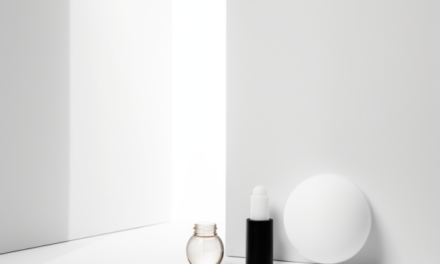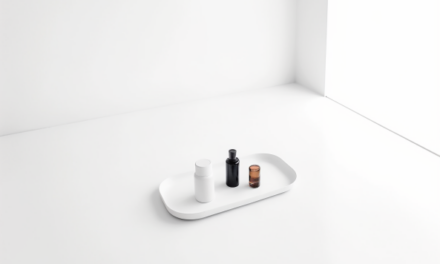Anti-Aging
Vitamin C – Ascorbic Acid
Ascorbic acid, also known as vitamin C, is a powerful anti-aging ingredient that has been extensively researched for its skin benefits. It can help reduce fine lines and wrinkles, fight other signs of photodamage, and reduce hyperpigmentation when used correctly. However, using ascorbic acid in a skincare routine can be challenging. This ingredient loses effectiveness quickly when exposed to air and light, and a high concentration is needed to have an effect on the skin. To get the most out of this active, look for a product with a 10%-20% concentration of ascorbic acid and try to use it up quickly after opening to prevent it from turning orange and losing its potency. And finally, be aware that using high concentrations of ascorbic acid can cause skin irritation.
What is ascorbic acid?
Ascorbic acid is simply the active form of Vitamin C that our body uses to support its functions. While many plants and animals can create this substance from sugar in their bodies, we humans can’t. We need to get it either from our diet or supplements. Research shows that applying ascorbic acid directly to the skin – like in skincare products – can also boost its levels in the skin.
Ascorbic acid is a weak acid that dissolves easily in water, but it’s also quite delicate. It can get destroyed by things like light, oxygen, heat, and heavy metals.
Role of ascorbic acid in skin
Ascorbic acid offers three main benefits to our skin:
- It protects our skin from damage caused by free radicals that result from sun exposure.
- It is essential for the production of collagen, which is key for wound healing and reducing wrinkles.
- It helps regulate melanin production in the skin, which can reduce pigmentation marks like age spots, acne scars, and melasma spots.
Let’s dive deeper into each benefit.
Battling sun damage
Our skin has high levels of ascorbic acid, even more than our blood, indicating our skin actively uses this compound. Why, you ask? The answer lies in its antioxidant properties.
Antioxidants are protective substances that save our cells from harm. When our skin is exposed to UV light, damaging molecules called free radicals are created. Ascorbic acid acts like a knight in shining armor, donating its electrons to neutralize these harmful molecules.
Over time, regular sun exposure reduces the amount of ascorbic acid in the skin. This can lead to signs of aging like sagging, wrinkles, and age spots. Studies have found that increasing the amount of ascorbic acid in your diet can reduce UV-induced skin damage. It’s worth mentioning, however, that while Vitamin C can aid in protecting your skin from the sun, you should still use sunscreen for complete protection.
Ascorbic acid and collagen production
Vitamin C plays a crucial role in the production of collagen. It directly takes part in its creation and also helps in its regulation. In fact, it acts as a helper molecule for the enzymes responsible for stabilizing and binding collagen molecules together. Vitamin C deficiency can lead to impaired collagen synthesis, resulting in a disease called scurvy. Studies confirm that applying vitamin C to the skin can increase collagen production, which can, in turn, help prevent wrinkles and support wound healing.
Ascorbic acid for skin brightening
Ascorbic acid can reduce skin pigmentation or dark spots. It does this by interacting with copper ions at the active site of an enzyme called tyrosinase. This interaction blocks the enzyme’s action, thus slowing down the conversion of an amino acid called tyrosine into melanin, which results in decreased pigmentation.
How to use ascorbic acid in your skincare routine: practical summary
If you’re seeking optimal results in protecting your skin from sun damage, lightening pigmentation, and boosting collagen production, adding Ascorbic Acid to your skincare routine is a smart move.
- For the best results, choose products with Ascorbic Acid rather than vitamin C derivatives, even if they’re marketed as “next-generation vitamin C” or “superior forms of Vitamin C.”
- Go for a product with an ascorbic acid concentration of 8%-20%. Use it once or twice daily, or less often if your skin is sensitive to avoid irritation.
- Applying ascorbic acid in the morning, under your sunscreen, can boost your skin’s protection against sun damage.
- When choosing an ascorbic acid product, apart from the concentration, ensure the packaging is opaque and airtight.
- Check the color of the product: it should ideally be clear or white. Avoid products that have a yellow or orange tint.
- If your product turns yellow after opening, this suggests that the ascorbic acid has started to degrade, and the product is likely not as effective anymore.
- If you’re using benzoyl peroxide or copper peptides, apply ascorbic acid at a different time (for instance, ascorbic acid in the morning and the other product at night). You can use niacinamide and ascorbic acid in the same step in your routine, but it’s better to let the first product fully absorb into the skin before applying the second one.
Can you get all the skin benefits of vitamin C from food and supplements?
Eating a healthy diet rich in fresh vegetables and fruits can provide your skin with a good amount of ascorbic acid. However, sun exposure and aging can reduce its concentration in your skin. While eating vitamin C-rich foods is good for your health and skin, if you want to really boost your skin’s ascorbic acid levels, it’s hard to achieve this just through diet or supplements. Most of the vitamin C you consume gets lost in our digestive system or gets distributed to other organs in your body. To maximize the skin benefits of Vitamin C, you should use a topical skincare product containing ascorbic acid in addition to a healthy diet.
Stabilizing ascorbic acid in skincare products
Skincare formulators use various techniques to stabilize ascorbic acid and improve its delivery to the skin in topical products. Some of the common techniques are:
- pH Adjustment: Ascorbic acid is most stable at a pH range of 2.5 to 3.5. Skincare formulators adjust the pH of the formulation to this range to improve the stability of ascorbic acid.
- Packaging: ascorbic acid products in opaque or airless containers protects them from light and air exposure.
- Antioxidants: adding other antioxidants, such as vitamin E and ferulic acid, to ascorbic acid formulations improves their stability and enhances efficacy.
- Microencapsulation: Skincare formulators use microencapsulation technology to encapsulate ascorbic acid in a protective shell, which prevents it from degrading and improves its delivery to the skin.
- Liposomes: Liposomes can encapsulate ascorbic acid and deliver it deep into the skin. Liposomes are small vesicles made up of phospholipids that can penetrate the skin effectively and deliver active ingredients.
Formulators also often use various derivatives of ascorbic acid, such as ascorbyl palmitate, ascorbyl tetraisopalmitate, magnesium ascorbyl phosphate, and sodium ascorbyl phosphate instead of pure ascorbic acid. Derivatives of ascorbic acid offer several benefits, including improved stability and better penetration into the skin. Unfortunately though, the derivatives do not seem to work as well in skin and pure ascorbic acid remains a better choice in skincare if you are looking for an anti-aging effect.
How to choose an effective skincare product with ascorbic acid: practical guide
Choosing a skincare product with ascorbic acid can be tricky. Ascorbic acid is unstable and the risk of spending your money on a useless vitamin C skincare product is, unfortunately, high. Here’s a practical guide to help you make the right choice:
Check the concentration
First, check the concentration of ascorbic acid. It should be between 8% and 20%. Products with less than 8% ascorbic acid might not be effective. Conversely, more than 20% might lead to skin irritation without giving any extra benefits.
Assess the formulation
Ascorbic acid is water-loving (hydrophilic), making it difficult for it to penetrate the skin’s water-repelling (hydrophobic) layer. Therefore, products with an acidic pH (4.2 and below) can help deliver ascorbic acid into the skin better.
Note, however, that acidic products can irritate sensitive skin.
Check if your product uses additional stabilisation techniques for ascorbic acid. These can be encapsulation, microemulsion or the inclusion of extra antioxidants like vitamin E and ferulic acid in the formula. These strategies keep ascorbic acid stable and effective for longer.
Look at the color
A good ascorbic acid product should be transparent or white. As ascorbic acid oxidizes, it turns yellow or orange, indicating that it’s no longer effective. If your product turns yellow, it’s time to toss it out. Stay away from products that are yellow or orange from the start.
Check the Packaging
The packaging of your product should be opaque and air-tight to protect the ascorbic acid from light and air, both of which can lead to degradation. Look for products with pump packaging, which are typically air-tight.
Shortcut: Use a checklist
Given the complexities, it’s unrealistic to measure the pH or investigate the chemical composition in detail for every product you buy. However, you can use this checklist to increase your chances of getting a good, effective product:
- Does the product contain between 8% and 20% of ascorbic acid?
- Does the manufacturer share information about the formulation of the product? They should ideally disclose the pH, additional antioxidants, and encapsulation or other formulation techniques.
- Is the product packed in an opaque and air-tight packaging?
- Does the product content come out as clear or white?
If the answer to all four is ‘yes’, you’ve likely found a quality product.
Keep in mind that creating an effective ascorbic acid product isn’t easy and requires investment from the manufacturer. If they’ve done it right, they will typically highlight this in their marketing. If you find a product where the manufacturer doesn’t disclose their formulation techniques, it might be best to avoid it.
Ascorbic acid for skin anti-aging: clinical evidence overview
A study conducted by Rhie et al. reported that the levels of ascorbic acid in the skin of both photoaged and naturally aged skin were lower compared to young skin. This suggests that external supplementation of ascorbic acid may help slow down the aging process in the skin. Clinical trials have been conducted to determine whether the topical application of ascorbic acid can increase collagen in the skin. Collagen is a protein that gives the skin its structure and elasticity.
In one study, 10 postmenopausal women applied a cream containing 5% ascorbic acid on one side of their upper forearm and a placebo on the other side. After six months of nightly use, the mRNA levels of collagen type I and type III in the skin biopsy were increased in the ascorbic acid-treated groups. However, there was no significant difference observed in the concentration of collagen extractable from the skin.
In another clinical trial, 19 subjects applied a 5% ascorbic acid cream twice a day to the extensor surface of one forearm for two weeks. Statistical analysis of all the subjects did not show a significant increase in procollagen level compared to the baseline before treatment. However, when the subjects were divided into a group with a low baseline procollagen I level and a group with a high baseline procollagen I level, the former group showed a significant increase in procollagen I level with ascorbic acid cream application. This suggests that ascorbic acid helps to increase collagen in the skin, especially or only when there is a lack of ascorbic acid or collagen.
In a randomized, double-blind, placebo-controlled study, 19 healthy female volunteers applied 5% ascorbic acid cream on the sun-exposed upper chest and forearm once a day for six months. The results showed that the application of ascorbic acid cream significantly increased the density of skin microrelief, decreased deep furrows, and improved the ultrastructure of the skin compared to the placebo treatment.
Another study enrolled 20 women with photo-aged skin and applied 23.8% ascorbic acid serum with iontophoresis on one side of the face once a day for two weeks. The results showed that the treatment significantly improved hyperpigmentation, surface roughness, and fine lines on the treated side compared to the other side that was spared for participants’ self-control.
In a double-blind, split-face, placebo-controlled clinical study, a dissolving microneedle patch containing ascorbic acid was applied around crow’s feet on one side of the face and a placebo patch on the other side for 12 weeks in 23 subjects with notable wrinkles near the eyes. The results showed that the ascorbic acid-loaded dissolving microneedle patch significantly reduced wrinkles in the crow’s feet area without causing skin irritation and sensitization problems.
In a double-blind, prospective, randomized clinical trial, patients underwent laser skin resurfacing procedure followed by topical treatment of 200 mg ascorbic acid with or without a cosmeceutical containing growth factors. Three months after the treatments, there was a significant reduction in skin roughness and the average depth of periorbital wrinkles in both groups. The group treated with ascorbic acid plus growth factors showed better results compared to the group treated with ascorbic acid alone.
While these studies suggest that ascorbic acid can help alleviate the symptoms of skin aging, it’s important to note that the number of studies conducted is not considered sufficient to confirm its efficacy. Additionally, the concentration of ascorbic acid used in the studies varies, and more research is needed to determine the optimal concentration and frequency of use.
Mixing ascorbic acid with other skincare ingredients
Ascorbic acid usually works well with most active ingredients in skincare, but there are a few exceptions:
- Benzoyl peroxide: It’s best not to use benzoyl peroxide and ascorbic acid together in one skincare step. To avoid any interaction, use one in the morning and the other in the evening.
- Niacinamide: There’s been some controversy about using ascorbic acid and niacinamide together as they might interfere with each other at high concentrations or in low-pH products. To sidestep this, find products that are specifically formulated with both ingredients, use them at different times of the day, or wait for about 5-10 minutes after applying the first one before adding the second.
- Copper peptides: There’s also debate about whether these can be used with ascorbic acid in one step without reducing effectiveness. To play it safe, use them in separate steps or wait about 10 minutes between applications.
How long before I see results?
The length of time it takes to see results from ascorbic acid skincare products varies depending on several factors, including the concentration of ascorbic acid, the formulation of the product, and the individual’s skin type and condition. Generally, it can take several weeks to several months to see noticeable improvements in the skin’s appearance and texture.
In some clinical trials, improvements in the skin were observed after six months of consistent use of ascorbic acid skincare products. However, some people may see improvements in their skin’s appearance after just a few weeks of use. It’s important to note that individual results may vary, and consistent use of ascorbic acid skincare products is necessary to maintain the benefits over time.
It’s also essential to remember that skincare products containing ascorbic acid work best when used in combination with other skincare practices, such as daily sun protection and balanced nutrition.
Safety & irritation risk
Ascorbic acid is considered safe even when used a lot over long periods. Any extra is usually expelled from the body through urine, preventing potential harmful buildups.
Allergic reactions to topical formulations of ascorbic acid or its derivatives are possible, but these cases are pretty rare. At the same time, products with high concentrations of ascorbic acid (above 10%) might cause skin irritation.
If skin irritation occurs, discontinue the product: there is no benefit in “pushing through” the irritation. Ascorbic acid also does not cause “purging”.
Ascorbic acid in skincare is considered safe during pregnancy and while breastfeeding.
Does ascorbic acid stain skin?
The simple answer is no, ascorbic acid itself does not stain the skin. Let’s delve a little deeper to explain why.
Ascorbic acid can easily be washed off with water and doesn’t leave any permanent or long-term coloration on the skin.
Yet, you might notice a slight orange tint after applying a product with ascorbic acid. This is because ascorbic acid oxidizes when exposed to light and air. So if you have a residue of ascorbic acid on your skin – which can happen especially when you use ascorbic acid in high concentration, it can turn yellow or orange and give your skin a tint. It is not a stain though and you can wash it off with water.
Effective concentration and frequency of use
Generally, concentrations between 5% to 20% have been shown to be effective in improving the appearance of the skin. However, higher concentrations of ascorbic acid can increase the risk of skin irritation.
In terms of frequency of use, it’s recommended to use ascorbic acid skincare products once or twice a day, depending on your skin’s sensitivity and other actives in your routine (use ascorbic acid less frequenlty if you are also using other potentially irritating actives like retinoids). Applying ascorbic acid products in the morning can provide added protection against environmental stressors such as UV radiation, while applying them at night can help promote photodamage repair.
Vitamin C derivatives: are they worth your while?
Scientists have been exploring ascorbic acid derivatives that offer greater stability in skincare products while still providing significant skin benefits. Although these derivatives may penetrate the skin well, their overall effects on the skin can be somewhat less clear-cut compared to ascorbic acid.
To put it simply, if you’re after the most potent and assured effects, ascorbic acid still reigns supreme in the realm of Vitamin C skincare. However, this is not to write off the derivatives entirely. They still hold value as effective antioxidants, can aid in collagen production, and may help tackle pigmentation issues. But it’s worth keeping in mind that their potency is generally lower compared to ascorbic acid.
Let’s take a closer look at some of the most promising Vitamin C derivatives that are making waves in the skincare industry:
1. Sodium Ascorbyl Phosphate and Magnesium Ascorbyl Phosphate: Stable and water-soluble, these two derivatives don’t quite match ascorbic acid’s ability to fight photodamage and prevent hyperpigmentation. However, they possess an additional advantage: recent high-quality studies suggest they can effectively combat clogged pores and acne, a benefit not found in ascorbic acid.
2. Tetrahexyldecyl Ascorbate: This lipid-soluble Vitamin C form offers more stability than ascorbic acid, though it still degrades over time and requires stabilizing ingredients in a formula. While it might penetrate the skin better than ascorbic acid and assist in fighting photodamage and decreasing pigmentation, there’s a lack of solid research confirming its effectiveness. It probably needs to be used in higher concentrations than pure Vitamin C, but even then, it may not be as effective as ascorbic acid.
3. Ascorbyl Tetraisopalmitate: Another lipid-soluble stable Vitamin C form, Ascorbyl Tetraisopalmitate, appears to function as an antioxidant and can help reduce pigmentation. However, its effects fall short when compared to ascorbic acid. The effective concentration is yet to be determined, but like other derivatives, it’s still a beneficial addition to skincare, even if not as potent as ascorbic acid.
4. Ascorbyl Glucoside: This is another stable, lipid-soluble form of Vitamin C. Ascorbyl Glucoside may help fight free radicals and reduce pigmentation. However, it requires a high concentration to work, and even then, it’s significantly less effective than ascorbic acid.
It’s also worth noting other Vitamin C derivatives, such as 3-O-Ethyl Ascorbic Acid and Ascorbyl Palmitate. While these might provide some antioxidant benefits, they don’t come close to ascorbic acid’s efficacy.
In conclusion, while Vitamin C derivatives offer various benefits and improved stability, none have yet to come close or to surpass the effectiveness of ascorbic acid in skincare. But if you’re simply seeking additional antioxidant protection and modest aid with pigmentation, these derivatives can still be helpful.
Sources
- Ascorbic Acid (Vitamin C) as a Cosmeceutical to Increase Dermal Collagen for Skin Antiaging Purposes: Emerging Combination Therapies https://www.mdpi.com/2076-3921/11/9/1663
- Detailed overview of clinical trials for ascorbic acid in skincare and additional sources: https://whatsinmyjar.com/skincare-ingredients/ascorbic-acid
- Topical Application of Ascorbic Acid and its Derivatives: A Review Considering Clinical Trials https://www.ingentaconnect.com/content/ben/cmc/2023/00000030/00000029/art00002#Supp
- Stability, transdermal penetration, and cutaneous effects of ascorbic
acid and its derivatives https://onlinelibrary.wiley.com/doi/abs/10.1111/jocd.12006 - Ascorbic Acid in Skin Health https://www.mdpi.com/2079-9284/6/4/58
Choose your products based on actives
WIMJ Search allows you to select skincare products based on what’s inside. Filter products by actives included, and exclude ingredients you don’t want. Check the concentration of ingredients and potential irritants.
Related Articles
Winter Skin Care: Navigating the Chilly Season with Healthy Skin
Let’s dive into understanding winter skin and how to best care for it.
Azelaic Acid: How It Works and Why You Might Need It In Your Skincare
Azelaic acid may not be the most hyped skincare ingredient, but, frankly speaking, it deserves way more recognition. Despite its underappreciated status, azelaic acid boasts a myriad of evidence-backed benefits, including combating acne, mitigating rosacea, addressing hyperpigmentation, and fighting against free radicals.
Sunflower Seed Oil: The Top Face Oil For Skin Barrier
Struggling to decide which face oil to choose? Sunflower seed oil might not be the most glamorous or exotic of skincare oils, but it could actually be the best for your skin.
Does Bakuchiol Help With Acne?
Discover how Bakuchiol, a plant alternative to retinol, can help combat acne. Dive into the latest research findings, learn the effective concentration and application tips, and uncover why Bakuchiol might be your new go-to for clear, happy skin.
CBD Skincare Benefits and Unknowns
Discover the impressive potential of CBD in skincare and learn about the risks. Our evidence-based exploration covers the CBD potential for treating acne, eczema, psoriasis and combating inflammation.
Thiamidol
Dive into our comprehensive guide to thiamidol, an effective tyrosinase inhibitor with impressive results against hyperpigmentation. Explore its science, evidence, and how to incorporate it into your skincare routine.
Is Petrolatum In Skincare Bad?
Get the facts about petrolatum, a top ingredient in skincare. Learn how this powerful moisturizer soothes, protects, and hydrates the skin. Plus, discover why it’s trending on social media and how it’s safe even for the most sensitive skin areas.
Can You Use Retinoids for Rosacea-Prone Skin?
If you’ve been grappling with the frustrating skin condition called rosacea, you may have been advised to steer clear of retinoids. This advice typically stems from concerns that retinoids can further irritate your already inflamed skin. But here’s something that may surprise you: retinoids, in fact, are commonly used in rosacea medical treatments.
Sensitive & Reactive Skin: What to Avoid?
If you have sensitive or reactive skin, what not to do is at least as important as what you actively undertake in terms of skincare. Learn what ingredients and skincare practices to avoid to reduce your skin sensitivity issues and help heal your skin barrier.
Opting for Fragrance-Free Skincare: A Skin-Friendly Choice
Opting for Fragrance-Free Skincare: A Skin-Friendly ChoiceIs the smell of your skincare products hurting your skin? It's a question we often don't think about. Yes, the scents can be nice, but they can also cause problems. About one in three skin issues from cosmetics...



